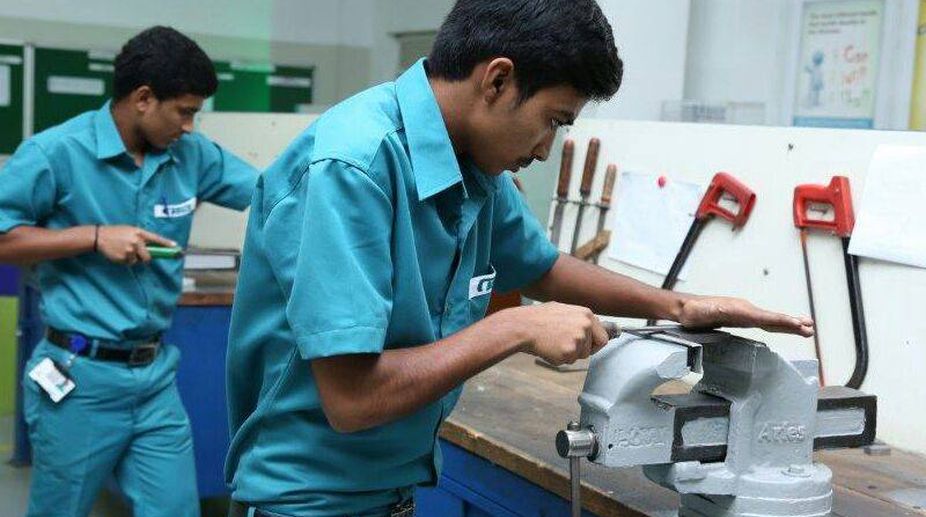With a young demographic profile, India is faced with the challenge of channelising its youth power towards an economically stronger future. As Census 2011 data suggests, more than 65 per cent of India's population is below 35 years of age. More than 50 per cent of its population is below the age of 25.
The focus of the present Union government too is to harness the energy and vigour of this segment of population by engaging them through different programmes, initiatives and schemes like, Skill India, Pradhan Mantri Kaushal Vikas Yojana and Deen Dayal Upadhay Grameen Kaushalya Yojana, to name some. Without getting into the good and bad of the newly-introduced as well as existing government schemes or initiatives in terms of outcomes for youth, one needs to analyse some broader questions: Are our youth ready to attain the skills provided under these schemes? Do they have the willingness and excitement to grab this given window of opportunities? Are they physically healthy to take up the challenge?
Advertisement
Health issues
Starting with the last question first, most of today's youth must have been around five years of age when the first National Family Health Survey (NFHS) was conducted in 1992- 93, across India. As per the findings of the survey, the chronic and acute under-nutrition was very high in India during that time. More specifically, 21-29 per cent of children were severely undernourished, according to weight-for-age and height-forage measures respectively, more than half of all children under the age four were underweight and a similar proportion were stunted.
According to the recently released NFHS-4 (2015-16) report, the situation of the children, who are now grown up, seems no better. As per the report, nearly 23 per cent of men aged 15-49 years are anaemic and nearly 19 per cent are overweight or obese. Among women, the situation is much worse ~ 53 per cent are anaemic and nearly 21 per cent are overweight.
Going by the lifestyle change over the past decade, adolescent and youth, particularly in Tier 1, 2 and 3 cities, consume more junk food, or fast food; are addicted to television, computer tablets, mobile phones and video games; and are less interested in outdoor games. One of the visible effects of this changed lifestyle is growing obesity. According to a WHO report, India is the third most obese country in the world. Every hour of sedentary activity increases the chance of obesity and is also contributory to failure of many weight reduction attempts in adolescents and children, according to an article by Manu Raj and R Krishna Kumar, Obesity in Children and Adolescents. A moot question, therefore, arises: Do the youth of today in India have a healthy physique and stamina to work for long hours and take up activities needing physical strength?
Not so keen?
It would next be pertinent to assess the extent of interest the youth have in attaining skills. One area of concern is job hopping, which is reported to be the highest in India. According to Ma Foi Randstad Work monitor survey (2010), India has the highest Global Mobility Index score of 141 ~ which means there is maximum employee mobility in India followed by China and Mexico. Apart from better job prospects, lack of skills is a major factor for an employee's low performance.
Seeking quick success and money may provoke a person to move to better jobs, thus defeating to a large extent the objective and purpose of skill training and support provided under various schemes. Due to fastchanging and fast-paced environment and work culture, youths are now excited more by comfort at work place and show less keenness to take up work or job requiring more physical effort. An example of this in rural areas is less interest among youth to work on farms. This could be attributed to an extent to their exposure to urban lifestyle.
Whether youth have the patience to wait for expected results, which may take some time to show, is a critical question for the success of Skill India's perceived outcome and engagement of youth on a sustainable basis.
Vacant positions in the defence forces is an example of youth preferring jobs, which are less tough and give the freedom to change. Urge and hunger for innovation continues to remain among just a few. Skill India and other capacity building and training initiatives aim to encourage youth to follow their aspirations. To provide an environment conducive to youth is what a government can do but even then the uncertainty attached with any model of business continues to exist.
Will the youth, in order to achieve the set target abide by the moral and ethically correct path in the face of severe competition? Will the balance between demand (government and private sectors) and supply (youth entrepreneurs) be maintained across the country? Checks and balances need to be well-positioned with minimal hiccups in the path to success.
To ensure that start-up businesses of youth are not affected by established entities will be a major challenge to ensure the success of Skill India.
The writer is director, CMS Social with Centre for Media Studies (CMS).He can be reached at alok@cmsindia.org









